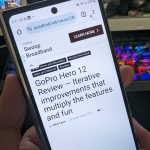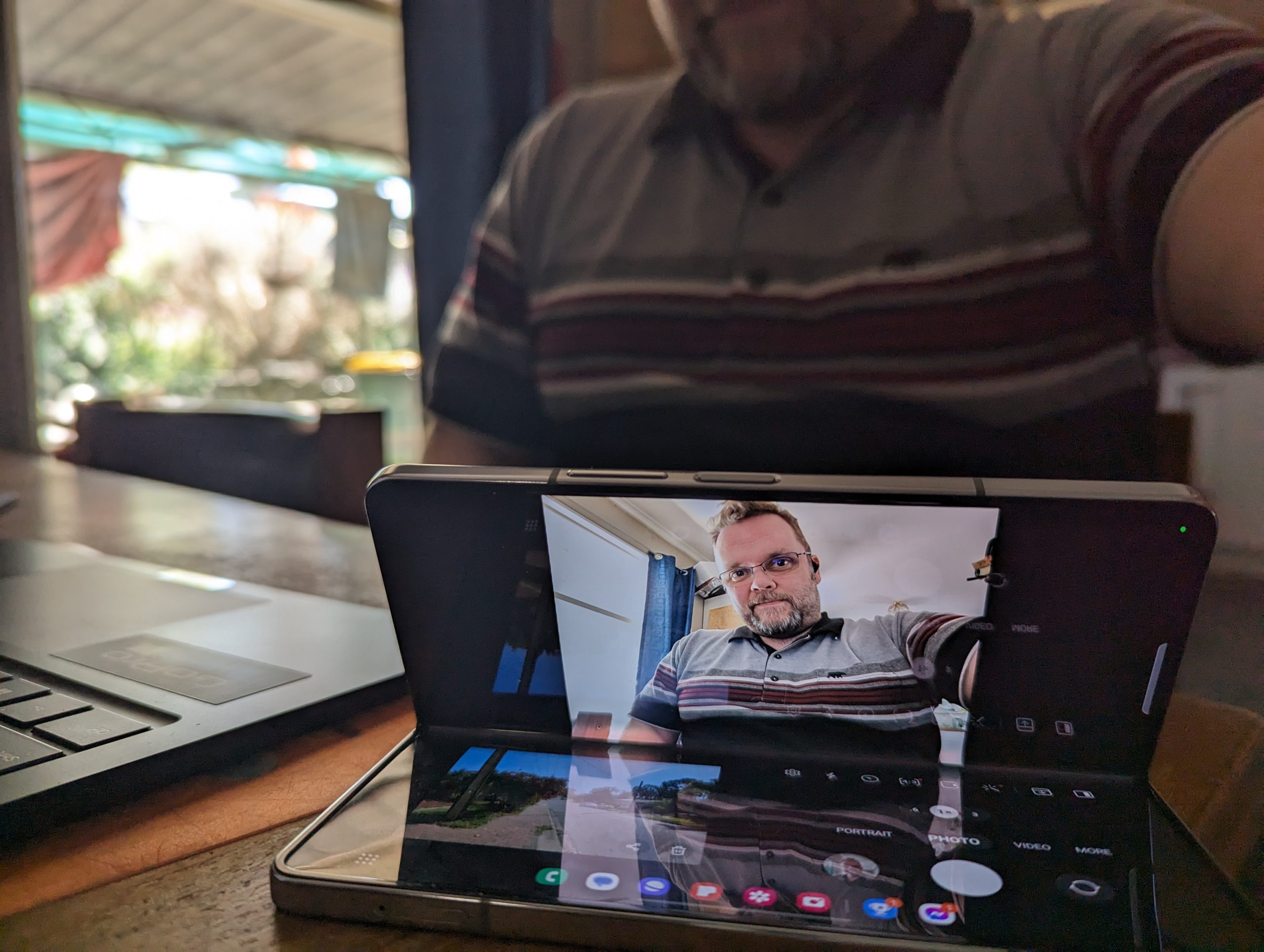The Galaxy Z Fold 5 is the “big daddy” of the folding device market at this point. It’s more mature (being 5th generation) than competitors, with a feature set and interface that users worldwide are familiar with and are very comfortable with. But is the Galaxy Z Fold 5 worth the huge price tag?
There are a couple of comments worth making in the early stages of this review; the biggest one is that there’s nothing hugely different from last year’s phone. So if you’re rocking a Fold 4, hold on to your money because this probably isn’t worth the upgrade for the iterative update on offer.
What is the Samsung Galaxy Z Fold 5?
As mentioned in the lead-in, it’s the folding (as opposed to flipping) Samsung device that folds out to an impressive internal screen that’s very capable of functioning as a tablet, or for larger screen media playback. That in itself is a really cool concept, and being the first folding phone I’ve reviewed, it’s taken me a while to adjust to the device.
In the early stages, I wasn’t sure — to be honest — how much I’d use the internal screen, but the extra screen space is handy. In a perfect world, I’d love to see it with the same screen size as a Pixel Pro device, then fold out to an even larger tablet, but that’s perhaps another generation or two away.
This is the 5th Generation of the Samsung Foldable devices, and right now, it’s one of the best foldable devices money can buy.
When the phone is closed, the front screen is a 6.2-inch display that runs 904 x 2316 resolution at a 23.1:9 ratio. The internal screen is a 7.6-inch HDR10+ screen with both running at 120Hz refresh, making them really easy on your eyes for heavy use throughout the day. On paper, the 1.4-inch difference in display size isn’t huge but in practicality, it is!
Both screens have great brightness levels which make them easy to use, even read clearly in bright light conditions and the touch response is fantastic. One of the major concerns I’ve had, and seen previously, was the hinge and closing gap on the screen. This is something that Samsung has addressed over the last couple of generations of foldable devices. The Fold 5 now folds flat with no space between the two sides of the inner screen, which goes a long way to preventing some of the issues of dust and dirt ingress to the screen while folded.
If you’re upgrading from a previous generation of Fold, or even the Note devices to the Galaxy Fold 5 there’s a bit of a problem: The S Pen is omitted. And if you buy an S Pen, you’ll need to buy a — probably the official — case that accommodates the Pen because there isn’t a recess in the device that supports it and add AU$278.00 to your $2,799.00 purchase price.
Performance and Battery Life
The internal specs of the Galaxy Fold 5 are pretty impressive when you look at them on paper. There’s a Snapdragon 8 Gen 2 “for Galaxy”, Adreno 740, 12GB of memory and options (256GB, 512GB or 1TB) for storage. You’ll have Android 13 staring you in the face out of the box and all the connectivity you can expect from a current-era device and while only a fleeting opportunity, this includes game performance.
All of this translates to snappy performance of the device in daily use whether you’re using either the front screen or opening the device and using the larger, internal screen.
As is often the way with phone batteries these days, you can get very good life out of it and you can decimate it quickly; I was able to send the Fold 5 flat in less than a day but I had to actively try…
As you can imagine, there are plenty of variables in the results, too, from the actual activities on the phone to brightness, the screen on time and — with the fold — whether you’re using the front screen or the larger, more battery-hungry inner screen.
The other, perfectly normal, variable is how aggressively you let the OS manage your apps. There are apps that users may wish to have always running in the background, such as communications, system monitoring or emergency service needs. With this in mind, the software optimisation and the power efficiency of the Snapdragon 8 Gen 2 all come into play. During testing, I consistently got a full day of use, occasionally — with multiple light use days — gone close to two days, 6 am off charge and into the evening the next day, from the battery. It’s a good, but not mind-blowing result – I’d like to get a full day of heavy use without concern and consistently two days from a phone this expensive and, frankly, big.
When you do get the battery down to levels where you’re seriously wanting some charge, I’d love to see the charging deliver a faster battery percentage. As it stands the Fold 5 supports 25W wired and 15W wireless, a far cry from some of the likes of OPPO who still leads the way in charging speeds, I’ve never had a drama with battery life on them, because they charge so damn fast!
Even if that was only up to — as an example — 70% of the battery capacity, then have adaptive charging kick in. There has to be an option somewhere between the conservative and the ridiculous that isn’t perceived as a risk.
In the relatively short time I had the fold, though, I didn’t have too many quiet days to test the battery. I was too busy testing as much as I could quickly to really get a feel for how good this thing is in a work environment. The short answer is it’s very good.
Being able to use it as an — albeit small — alternative to grabbing my laptop out for remote support, reading emails and looking over spreadsheets made life much easier.
There’s so much grunt in this thing that it effortlessly deals with multi-tasking, split screen operations and even (although it does deplete the battery quickly) hot-spotting to a laptop while on the go.
The Camera: It’s very “Samsung” but it’s not their best option
This was one area I’d like to have seen a little bit more from Samsung on a device that costs this much. Even putting in the S23 cameras would improve what’s on offer. That’s not to say that the Galaxy Fold 5 cameras are bad by any stretch; more to note that Samsung can and has produced “better”.
The formula for cameras on the Fold 5 is remarkably similar to that of the Fold 4, offering 12MP Ultrawide, 50MP wide and 10MP Telephoto options. This is where it gets a bit tricky, though, because there are some tricks in the folding setup of the phone that give far better results than other devices; let me explain.
Yep, there’s a 4MP in-display (hole punch) camera that does a really good job of selfies, but you can open up the device like a miniature laptop; frame your photo and set a timer with the — significantly better — portrait mode. This is a great option too if you’re using the zoom as laying the phone on a stable surface is always going to get a better photo than holding the camera.
There’s another camera in the inner screen that is also available for users needing some selfie action in “tablet mode”.
Don’t take this as a criticism of the camera or the photos that it produces, but having seen some of the results from the S23 Ultra earlier this year, I know Samsung can do better, but at what cost? Given there are already five lenses in the Fold 5 (front and inner selfie cameras, plus the three rear) there would be sacrifices elsewhere, such as physical size, weight or potential loss of battery capacity.
Ultimately, you’ll get some nice photos in a variety of lighting conditions. In fact, I had to really try (tracking a fast-moving target) to get a bad photo. The aperture speed, plus the capability of the software to post-process — removing blur and correcting colour and light — meant that photos were of a consistently high quality, although the colour could be a little oversaturated at times.
Final thoughts: It’s a winner for the right users
Foldable device market penetration is only going to increase in the coming years. Now, there are more manufacturers in the flip space and getting it right (OPPO and Moto with the razr 40 Ultra and razr 40) more are surely coming to challenge Samsung in the Folding space…
If you’re new to foldable devices though, there is a very steep learning curve. I had to force myself to open the device and use the inner screen for a while. Now I’ve completed the review, I find myself trying to unfold my normal (non-folding) daily driver. But that effort is worth it for the extra functionality and, more importantly; the productivity you’ll gain.
At AU$2,599 for the 256GB version and AU$2,799 for the 512GB version, I’d have preferred to see the S-Pen and an official case included. But the reality is not everyone will want or use them, so it would be something of a waste. That and I’m not sure that the new S-Pen — being thinner and smaller than the older style — is actually as useful.
If I had a Galaxy Fold 4, I wouldn’t be upgrading to the Fold 5; but if I was looking at my first Folding phone this would absolutely be the one. There aren’t any huge problems with it — lets see how the screens fare in another 12 – 18 months time — and the technology has developed over last years option.
If you’re looking at the Samsung Galaxy Fold 5 it’s stocked in the usual retail channels, the Samsung stores (online and in person) and, of course, your chosen major carriers.





















